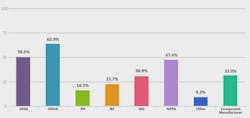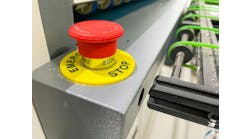For many North Americans, the term “Machinery Directive” suggests something having to do with industrial equipment sold by a company located in one part of the European Union to another company in a different part. But, for many producers of that equipment, the Machinery Directive means a comprehensive set of standards that can help them to design their products with greater confidence and a higher level of safety.
Even though the United States is not part of the European Union, a growing number of U.S. machine builders and equipment producers are following the standards outlined in the Machinery Directive because it is the most comprehensive set of standards available and has more or less become the go-to global standard safety. Compliance with the Machinery Directive is essential for any company planning to export their products to an EU member country or to other countries that often follow it, such as Mexico. Following a single set of standards also helps to eliminate confusion when faced with multiple U.S. standards and standards from other countries.
A survey conducted by Control Design magazine in 2015 asked U.S. machine designers where they got most of their safety guidance and applicable standards information. The answers were all over the map because safety information is woven through multiple standards and guidelines, including OSHA, NFPA, ANSI, IEC, ISO and others (Figure 1). The survey also revealed significant confusion about the most appropriate sources and that many use the Machinery Directive to ensure global conformity.
Figure 1. OSHA, ANSI and NFPA are just three of many organizations where machine designers get their safety guidance and applicable standards information.
Ensuring machine safety is always a top priority in manufacturing for both the machine builder and the machine buyer. For European manufacturers, using CE-certified machinery and components is the best way to ensure the reliability of the equipment, which benefits production and the operators who use the equipment.
Just what is it?
The Machinery Directive was first published in 1989 with the intent of ensuring a common safety level in machinery placed on the market or put in service in all EU member states and to remove barriers to trade within the European Union by stating that "member states shall not prohibit, restrict or impede the placing on the market and/or putting into service in their territory of machinery which complies with (the) Directive."
In 2009, Directive 2006/42/EC of the European Parliament became law in Europe and its primary role is to ensure common safety levels of machinery placed on the market and put into service. Today, the Machinery Directive establishes the foundation and regulatory basis for the harmonization of essential health and safety requirements (EHSR) related to machinery. It is unified with CE requirements and covers almost 21 distinct EN standards to guide machine builders on safety requirements. Ultimately, it has become the foremost global authority on where to go for information on designing a safe piece of equipment.
The Machinery Directive is unique in terms of its broad coverage for machinery design. The standards start at concept of design or designing out risk. The directive mandates a technical file be kept on the machine to show its inception and what risk avoidance was implemented to create a safer machine.
Machinery builders are provided with guidance in the form of EN standards, which mandate conducting a risk assessment on machinery. Finally, the Directive includes information on machinery’s end-of-life disposal. Although it is broad, it does an excellent job of ensuring safety is addressed at every level; it even accounts for “unintended use of machinery” at the design stage.
Although one of the primary purposes of the Machinery Directive is to ensure common safety, it does not mandate the use of safety-rated products. However, it does clearly differentiate between standard components used in a safety application and products built and intended as safety-rated products. Safety-rated products are classified separately and are subject to more rigorous requirements, testing and expectations for performance.
The Directive mandates the use of commonsense safety strategies on machinery, such as the use of e-stop buttons, the removal of air in a machine to protect against unexpected movement where safe to do so and the addition of technical measures where risk cannot be designed out. Additionally, to meet enhanced safety levels on machinery, redundancy and monitoring must be included in the controls of the machine in accordance with EN ISO 13849-1, as well as validation of the system in accordance with EN ISO 13849-2.
EN ISO 13849-1 provides safety requirements and guidance on the principles for the design and integration of safety-related parts of control systems (SRP/CS), including the design of software. EN ISO 13849-2 specifies the procedures and conditions to be followed for the validation by analysis and testing of the specified safety functions, the category achieved, and the performance level achieved by the safety-related parts of a control system (SRP/CS) designed in accordance with ISO 13849-1.
A growing number of machine component manufacturers are now offering safety-rated components engineered to comply with the Directive. Because pneumatics is part of the safety-related parts of the control system, machine builders should consider adding a safety exhaust valve of this type into a machine’s air preparation system. The use of a safety exhaust valves allows users to shut off the pneumatic energy safely and reliably, stopping the flow of compressed air to the machine and allowing the downstream pressure to exhaust out. For example, the safety function can be activated when an operator is reaching into hazardous areas or during an e-stop condition.
Knowing that products are now available that incorporate the needs of the Directive and provide an enhanced level of certified safety can offer machinery designers and the engineers responsible for enhanced and integrated machine safety greater peace of mind as they take on subsequent design projects.







